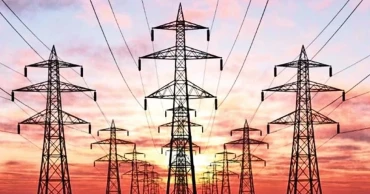power
Banking, power, revenue reforms in focus as govt faces IMF debt concerns: Salehuddin
Finance Adviser Dr Salehuddin Ahmed on Tuesday said the government is moving forward with reforms to stabilise the banking sector, rationalise subsidies in the power sector, and strengthen revenue mobilisation, while remaining cautious about growing foreign debt under the IMF programme.
Briefing reporters after a meeting at the Secretariat, the adviser said syndicates and rent-seeking practices remain a challenge in the domestic market but stressed that enforcement measures have been intensified to reduce extortion and safeguard consumers.
Dr Salehuddin, however, admitted that extortion has increased across the country since August 5 last year, saying the interim government alone cannot control the menace without political commitment and an elected government in place.
The adviser said the problem has worsened in recent months. “Where previously one taka was being extorted, now it is one and a half or even two taka. After August 5, multiple groups became involved in extortion, while those who were active before are also still behind it. Many of those engaged in extortion are members of business organisations,” he said.
Dr Salehuddin observed that extortion is fueling price hikes. “This is one of the reasons why commodity prices are increasing. But it is not the direct responsibility of my ministry to control this. The interim government does not follow a ‘catch this person, catch that person’ policy,” he explained.
The adviser, however, expressed optimism that inflationary pressures will ease in the coming months. “By June next year, we expect inflation to come down to around 7 percent,” he said.
Dr Salehuddin noted that although the banking sector went through a difficult period marked by liquidity pressures and complications in opening letters of credit (LCs), the situation has eased.
“We are seeing greater stability now. LC-related barriers that disrupted imports last year are no longer acute. Weak banks are being supported to remain afloat, but we are not allowing irregularities to go unaddressed,” he said.
Process to recover laundered money progressing gradually: Finance Adviser
The adviser emphasised the urgent need to broaden the tax net.
“The National Board of Revenue (NBR) has already rolled out the National Single Window digital system, which is streamlining customs and taxation processes. For the first time, many powerful individuals who had previously remained untouched are receiving tax notices,” he said, adding that strengthening a culture of compliance is central to restoring fiscal balance.
Turning to the power sector, the adviser said subsidies have reached an unsustainable level.
“The government has already spent massive amounts to keep electricity affordable. It will not be possible to increase subsidies further. Power companies must now work to reduce their own costs and improve efficiency,” he said, indicating that future tariff adjustments would have to be more carefully managed.
Dr Salehuddin said that the government is reviewing pension reform models, including a “one pay, one pension” framework, but stressed that a universal pension system will take more time to materialise.
“It will be a gradual process, requiring strong financial backing and careful implementation,” he explained.
Commenting on the upcoming national election, the adviser observed that the political climate has been relatively calm.
“Major parties have expressed interest in contesting, which is a positive sign. The army, along with other law enforcement agencies, will play a critical role in maintaining law and order during the electoral process,” Dr Salehuddin said.
Finance Adviser stresses strengthening capital market to reduce bank dependency
He also stressed the importance of maintaining stability in the country’s foreign reserves by prioritising payments to international investors and curbing capital flight.
“Foreign reserves are lower compared to previous years, but the situation is not yet at a crisis level. Our commitment to honouring international payment obligations remains firm,” he noted.
The finance adviser concluded by urging transparency, accountability, and continued reforms across economic sectors. “Bangladesh still has policy space to steer the economy, but sustaining reforms is essential to protect public trust and strengthen resilience against external shocks,” Dr Salehuddin said.
3 months ago
Cyclone Remal leaves 2.22 crore people without power
Power supply to 2.22 crore consumers of the Bangladesh Rural Electrification Board (BREB), out of its total 3.58 crore, has been suspended following the landfall of cyclone Remal on Sunday (May 26, 2024).
According to a top official of the BREB, these consumers are living in the areas belonging to 61 Palli Biduyt Samities (PBSs), out of a total 81.
“The areas where power supply remained off till Monday since the hit of the cyclone are mainly located in the coastal belt of the country,” he told UNB.
Impact of Cyclone Remal: Rain disrupts commute for office workers, students in Dhaka
He, however, said mainly the power transmission was halted to those cyclone-hit areas as part of a cautionary measure to avoid any accident.
With the improvement of the situation, gradually the power transmission and distribution system will be checked and restored, he added.
Cyclone Remal: 2 die as roof collapses in Barishal
He noted that it’s still not clear how much damages were caused by cyclone Remal. “We’re now receiving information from the cyclone affected areas,” he said.
Ministry of Power, Energy and Mineral Resources took some measures including opening control rooms on Sunday to deal with the cyclone.
1 year ago
Metro Rail services resume after nearly 2 hours
Dhaka Metro Rail services resumed after nearly two hours of suspension this morning (May 27, 2024).
Nazmul Islam Bhuiyan, deputy director (public relations) of the MRT Line-6 project, said the operations remained suspended due to problem in power sypply.
Suspension of Metro rail service causes immense suffering to city dwellers
Wishing anonymity, an official of Dhaka Mass Transit Company Limited, said the electric power supply for the metro rail was halted due to technical reasons. This problem occurred on Bijoy Sarani-Shewrapara line around 7:30am, he added.
However, the services resumed after 9am, he said.
Quader expresses discontent over NBR’s move to impose 15% VAT on Metro rail
1 year ago
BPDB to bear the brunt after recent hike in US Dollar rate
Bangladesh Power Development Board (BPDB) is going to bear the brunt after recent enhancement of US Dollar rate as it will have to spend an additional amount of over Tk 7,300 crore to purchase electricity from the private sector.
According to official sources, the BPDB's annual spending was roughly calculated as Tk 104,000 crore for purchasing electricity from the independent power producers (IPPs) for the fiscal year 2023-24. The total expense will now go up to about Tk 1,11,300 crore, according to officials familiar with the estimate this week.
But after the increase in the rate of USD by the central bank through the introduction of a crawling peg system, the BPDB has been a great victim of such a decision.
The Bangladesh Bank on May 8 unveiled the crawling peg exchange rate system and allowed banks to buy and sell US dollars freely near Tk117, as well as letting go of its regulatory power of the Smart rate, and hiking the repo rate.
360 MW Haripur unlikely to get extension despite low cost electricity: Sources
Under this system, a crawling peg mid rate (CPMR) has been set at Tk117 per US dollar with immediate effect.
Scheduled banks may purchase and sell US dollars freely around the CPMR with their customers and in interbank deals, the notice also said.
A crawling peg system is a method of exchange rate adjustments that allows a currency with a fixed exchange rate to fluctuate within a band of rates. It is a hybrid of fixed and floating exchange rate systems.
"The payment mode of the power purchase agreements (PPAs) with the IPPS is in USD. So, we have to incur a huge financial loss when the USD rate goes up", a top official of the BPDB told UNB.
As the issue is very sensitive, preferring anonymity, he said the BPDB's loss will be enormous this year as the dollar rate went up in one go by Tk 7 to Tk 117 from the Tk 110.
He said the extra burden of paying Tk 7,300 crore will complicate the situation when the International Monetary Fund (IMF) has been insisting on reducing government's loss in buying electricity from the private sector.
Differing reserve figures stirring market instability and consumer price hikes
He noted that The BPDB has to spend over Tk 12 in each unit of power generation while its average selling rate is about Tk 8.95 with incurring over Tk 3 per unit.
"The IMF has repeatedly been putting pressure on the BPDB to raise the electricity tariff to reduce the financial loss. Now, after enhancement of the USD rate, the financial loss will be tough to manage", said another official of the BPDB.
He, however, said despite the pressure from the international lending agency, the BPDB has not taken any decision to raise the tariff shortly.
Power and energy sector likely to get Tk 804 billion allocation in next two fiscal years
"The Power Division and the BPDB have been making their own calculations about the impact of the USD rate enhancement. The final decision will come from the government if any decision is taken politically to raise the power tariff", added.
The BPDB annual report reveals that as the single buyer in the power sector, the organisation's operating expense was Tk 93,797.37 in the fiscal year 2023-24.
1 year ago
360 MW Haripur unlikely to get extension despite low cost electricity: Sources
Haripur 360 MW combined cycle power plant (CCPP), which generates electricity at lowest cost, is unlikely to get extension after completion of its 22-year initial contract period.
According to official sources, the power plant, established by leading US company AES Corporation in 2001, completed its successful operational period in November 2023. Since then, the government has not taken electricity from the plant.
The AES Corporation developed two large base-load power plants—Haripur 360 MW CCPP in 2001 and Meghbaghat 450 MW CCPP in 2002—with the highest efficiency, but lowest cost.
As per the power purchase agreement (PPA), state-owned Bangladesh Power Development Board (BPDB) had been purchasing electricity from the two first generation independent power producer (IPP) plants.
BPDB officials said that initially, Haripur's power tariff was Tk.1.56 per unit, which is the lowest not only in Bangladesh, but also in the world.
According to a World Bank document publicly disclosed on June 24, 2014 which compared the power generation cost of different IPPS, shows that when the Khulna Power Company Limited was selling electricity to the BPDB at Tk 16.03 per unit in 1998, NEPC at Tk 20.20 per unit in 1999, Haripur was selling it at Tk 1.56 per unit and Meghbaghat was selling power at Tk 2.33 per unit.
Read more: Bangladesh to provide 190 acres of land in Kurigram for Bhutanese investors; discussion to import hydropower underway
Currently, the average generation cost is over Tk 10 per unit. Through a gazette notification issued on March 1, the government set the retail tariff of electricity at Tk 8.95.
Officials said, until last year BPDB was buying electricity from the plant at Tk 3.32 per unit which was the lowest among all other private power plants.
But in November 2023, the PPA expired and BPDB suspended purchasing electricity from the plant.
The BPDB’s such move surprised many as it was unlikely on the part of the government that it unilaterally stopped buying electricity from the most efficient and lowest cost power when it continued purchase of electricity from high cost plants belonging to Summit Group and other plants.
“Actually, there was no strong lobby on behalf of the Haripur plant to pursue the government to renew its contract with the BPDB. That’s why the country will be deprived of the low cost electricity,” a top official of the BPDB told UNB requesting anonymity.
He, however, said the government can offer the owner-company of the Haripur plant to buy it and operate under the BPDB management.
Read more: Power cuts plague Sylhet: Frustration growing among residents and businesses
Sources said the USA-based AES Corporation developed the Haripur and Meghnaghat power plants, after a number of changes into their ownership. Now Malaysian Pendekar Energy Limited owns and operates the two plants.
In 2003, AES sold the plants to the UK company CDC Globeleq, which sold the plants to Malaysia-based Pendekar Group in 2007.
Official sources said the government had to pay Tk 50-55 crore a month to purchase electricity from the Haripur power plant for its 360 MW electricity.
“But from November 2022, the operator of the plant has not been receiving any bills from the BPDB for which it lost interest to continue its operation”, said another source.
He also mentioned that BPDB is also not interested to extend its operation as it has contractual obligation to buy electricity from newly established plants like Summit Group’s Meghnaghat Plant, Unique Group’s Meghnaghat plant and also some coal –fired power plants which electricity cost is between Tk 6.50 to Tk 30 per unit.
Read more: First private sector solar project in Bangladesh secures $121.55 million funding from ADB
1 year ago
Nor’wester damages hundreds of houses in Faridpur
Around hundreds of houses were damaged while a number of trees were uprooted during a nor’wester in Faridpur district early Thursday (March 28, 2024).
Twenty villages under Pachuria and Bana unions in Alfadanga upazila of the district were battered by the storm.
Residents of the 20 villages – Sirgram, Garania, Pakuria, Taboni, Tonapara, Sialdi Charpara, Joydebpur, Aushir haat, Kutharakandi, Majpara, Arpara in Bana union; Jugibarat, Bhatpara, Chandra, Pachuria, Deuli, Charnarandia, Dhuljuri and Charbhatpara in Pachuria union – remained in darkness as many electric wires were also snapped during the storm.
A vast track of cropslands were also damaged while trees were uprooted, halting road communications in different parts of the upazila.
Read more: Rains likely in parts of Dhaka, 7 other divisions
AKM Zahidul Hasan Zahid, chairman of Alfadanga upazila, said the storm started sweeping through the upazila around 1 am.
Many people have taken shelter under the open sky as their thatched houses were blown away during the storm.
Additional General Manager of Alfadanga Sub-zonal officer of Palli Bidyut Samity, said some electric poles were uprooted while some wires got snapped, disrupting power connection.
Work is going on to resume power supply, he said.
Quamrul Ahsan Talukdar, deputy commissioner of Faridpur, said directives have been given to provide all-out support to those affected in the storm.
Read more: Women's perspectives are vital in climate action: Environment Minister
1 year ago
Water Battery: What's Special About It
Lithium-ion batteries have been ruling the world for storing electricity since they were invented. From simple charger lights to giant electric cars, most modern devices use lithium-ion batteries as their powerhouse. However, they have gone a little off-fame for their explosive nature and safety concerns for large-scale grid energy. To overcome the risk, a multinational team of scientists, researchers, and industry collaborators have come up with the world’s first water batteries. These batteries are claimed to be less toxic, recyclable, and incombustible.
What is a Water Battery?
The concept of a water battery is not avant-garde. However, experts have been trying to make an ideal version of such a battery to use in the industrial field for a long time and finally succeeded. A traditional battery uses organic electrolytes as a conveyor of electricity between negative and positive edges. Interestingly, in a water battery, pure and plain water serves as the electrolyte.
It took a fair deal of effort to make a water-based battery an acceptable, stable, and modern technology that is usable all across the digital industry. In the manufacturer's terms, these batteries will be termed as aqueous metal-ion batteries.
Read more: Most Anticipated Smartphones Coming in March 2024
Invention of Water Batteries
A team led by RMIT University and headed by Distinguished Professor Tianyi Ma developed recyclable 'water batteries.' These batteries are safer than lithium-ion ones, as they don't catch fire or explode. They utilize water instead of volatile materials. The team's breakthroughs in aqueous energy storage devices significantly enhance performance and lifespan. Their manufacturing simplicity allows mass production, utilizing abundant, inexpensive materials like magnesium and zinc.
Unlike traditional batteries, water batteries use water as an electrolyte, replacing hazardous substances. They work similarly to lithium-ion batteries but without the associated risks. Additionally, managing water levels in these batteries is crucial for longevity and requires periodic replenishment to maintain efficiency. This innovation offers a safer, more environmentally friendly energy storage solution for various applications.
1 year ago
Action against officials of Petrobangla companies if fail to achieve target: Nasrul
Bangladesh's State Minister for Power, Energy and Mineral Resource Nasrul Hamid has said that each of the companies of the Petrobangla will be given target to drill wells in the gas fields for hydrocarbon exploration and if they fail, the officials concerned will be removed from their posts.
“Nobody will be speared and no persuasion will be accepted against any failure”, he told a seminar titled: “Gas Demand-Supply Scenario; Scope of Seismic Survey and Enhancement of Drilling Activities to Expedite Hydrocarbon Production” organised by Petrobangla at its auditorium in the city on Thursday (February 15, 2024).
Expressing frustration over the activities of the Petrobangla, he said that there is huge deficiency in the organisation and its subordinate bodies to work as a team.
“They don’t work in a coordinated manner. As a result, sometimes gas is found in a well, but processing plant remains unprepared to supply the gas to the national grid,” he said.
Read: Dhaka’s air quality still 'unhealthy', 2nd most polluted in the world this morning
“Sometimes it takes 4 years to get gas supply from a well to the national grid,” he added.
He said Bangladesh Power Development Board (BPDB) and other entities in power sector have been successful in achieving the goal of 100 percent electricity access as they worked as a team.
The seminar, with Petrobangla chairman Zanendra Nath Sarker in the chair, was also addressed by Energy Secretary Md Nurul Alam.
Bakhrabad Gas Distribution Company’s Managing Director Anwarul Islam and Petrobangla’s general manager Meherul Hasan made presentation on the topic of the seminar.
Nasrul Hamid said the Petrobangla planned to drill 48 wells to produce 500 million cubic feet per day (mmcfd) while the country’s demand will go up by 2000 mmcfd.
Read: New executive committee of BSFA pays homage to Bangabandhu
“We’re all looking at Petrobangla to see effective results of its plan…, there is huge prospects in the gas sector,” he added.
He said the country has many inefficient captive power plants which efficiency is 20 percent when some new power plants installed with 62 percent efficiency.
“If we can divert gas to those efficient new power plants, power production cost will come down by 70 percent,” he noted.
In the presentation the Petrobangla officials showed that it has planned to drill 100 wells across the country from which 1500 mmcfd gas will be produced by 2027 when gas demand will go up to 6000 mmcfd.
Read more: Nasrul Hamid seeks ADB's help to create regional power market
1 year ago
Govt in dilemma over raising power tariff or floating more bonds to cut losses
The government of Bangladesh is caught up in a dilemma in choosing the right option to reduce the gap between the cost of power production and revenues generated from sales.
“Top policymakers are divided over whether the government should go for increasing the power tariff further or issuing more bonds through the banking system,” said a top official at the state-owned Bangladesh Power Development Board (BPDB).
He said if the government wants to raise the power tariff, either it has to do it before Ramadan or after Ramadan - these are the questions almost every day that are being discussed at the policy level.
They are also analysing the impacts of floating more bonds to reduce the burden of soaring losses on the part of BPDB, he added.
Read: Retail power tariff hiked 5% to Tk0.19 per unit for lifeline consumers, Tk0.36 on average for others
According to official sources, currently, the production of each unit of electricity costs about Tk 12 while it sells at a rate of about Tk 6.7.
It means the government has to bear the brunt of Tk 5.3 per unit, a top BPDB official told UNB.
The BPDB’s Annual Report 2022-23 shows, the BPDB, as a single buyer, generated 87,024 million kilowatt hours of electricity in 2022-23 fiscal at a total cost of TK 98,646.42 crore.
Its per unit production cost was at Tk 11.33 while it was selling electricity at Tk 6.7 per unit incurring a loss of about Tk 4.63 per unit.
The bulk tariff was last raised by 8.06 percent to Tk 6.70 from Tk 6.20 per unit on January 31 with effect from February 2023.
Read more: Over 10,000MW power in 29 projects in the pipeline, despite yawning overcapacity
Against this, its revenues were Tk 50,858.25 crore, incurring a loss of Tk 47,788.17 crore, showed the BPDB Annual Report.
With this huge loss, the government has been in great trouble as it has to purchase electricity worth Tk 82,778.25 from private sector power producers while it generates electricity worth Tk 13,306.62 crore from its own generation plants.
The annual report also shows that the BPDB’s average per unit production cost from its own plants is Tk 7.63, while it is Tk 14.62 at the independent power producers or IPPs (private sector), at rental plants Tk 12.53, at public plants Tk 6.85 and imported power from India at Tk 8.77.
The government purchases electricity from the private sector and India in dollars.
Read more: Power generation capacity increased by almost 20% to cross 30,000MW in 2023
According to official sources, the government's cumulative outstanding bills have now jumped to about $5 billion, of which the backlog amount in the power sector is about $4 billion (about Tk 43,093 crore), and the remaining $1 billion is in the energy sector.
State Minister for Power, Energy and Mineral Resources Nasrul Hamid also admitted the severity of the crisis.
“Actually the crisis is not of local currency. Somehow we can manage it. But the main crisis is the dollar. We’re not getting dollars from Bangladesh Bank as per our needs,” he recently told UNB.
He noted that the power and energy sectors need at least $1 billion a month to meet payment obligations.
Read: Govt to raise retail power tariff this month
In such a situation, the government recently introduced a number of bonds through Bangladesh Bank to facilitate the BPDB to clear some dues.
“Initially, we have floated bonds worth Tk 5000 crore and it may go up to Tk 12,000 crore,” said a BPDB official on condition of anonymity, adding that it will not be enough to cover the losses, although the government is providing subsidies on a regular basis.
“That’s why the government will have to go for raising power tariff further or introducing more bonds,” he said adding, if more bonds are floated, it may squeeze the private sector’s credit from the banking sector.
But a final decision on what they would do still remains pending.
Read more: Power, energy sectors are saddled with $5 billion outstanding payment amid dollar crisis: Sources
1 year ago
Over 10,000MW power in 29 projects in the pipeline, despite yawning overcapacity
Some 29 more power generation projects, having a combined capacity of 10,881 MW are now under construction, even as the country struggles to manage the costs of overcapacity to the tune of 40 percent in the power sector.
The recently published “Annual Report 2022-23” of the Bangladesh Power Development Board (BPDB)contains information on the under-construction 29 power generation projects.
It said, “Diversified fuel-based power generation expansion plans are adopted to meet the ever growing electricity demand in Bangladesh. As a part of these plans, 29 power generation projects of capacity 10,881 MW are now under construction, out of which, BPDB is directly implementing 5 projects of capacity 730 MW and 17 projects of capacity 4,230 MW through the IPP sector.”
The annual report further said, “The plan envisages around 20,416 MW new generation addition from July 2023 to December 2027, out of which 728 MW capacity has already been added up to September 2023.”
Many experts in the power and energy sector believe that keeping a 40 percent surplus, adding another 10,881 MW to the national grid in the next three years will further increase the burden of capacity payments, which are written into contracts with independent power producers, as the private sector players owning power plants are referred to.
Power, energy sectors are saddled with $5 billion outstanding payment amid dollar crisis: Sources
Of the total 29 projects, 5 are in the public sector while17 are in the private sector as independent power producer (IPP) projects, the annual report said. The ownership structure of the remaining 7 is not clear, with some hybrid combination possible.
According to available data, the country’s overall power generation, combining grid capacity and off-grid (mainly captive) power, increased by about 5000MW in 2023 to reach a new benchmark of 30,700MW, although with demand failing to keep up, this is expected to lead to higher capacity payments for the government.
This is disclosed in available data from the state-owned Bangladesh Power Development Board (BPDB), Bangladesh Energy Regulatory Commission (BERC) and Sustainable and Renewable Energy Development Authority (Sreda).
The BPDB data shows that of the 5000MW new power generation, some 3,343MW was added to the national grid by the import electricity from India and production from newly set up local power plants while about 1400MW came from off-grid captive and off-grid solar power.
It also shows that the country’s installed grid-connected power generation capacity has reached to 25,951 MW on December 30 in 2023 from 22,608 MW in 2022 showing a capacity enhancement of 3343 MW.
Oil companies attending climate talks have minimal green energy transition plans
Beyond the national grid, as per BERC data, the captive power generation has increased by 1379MW to reach 4760 MW in 2023 from 3,381MW in 2022.
The captive power plants were mainly set up by industries for their own consumption to get uninterrupted power supply as the grid power does not guarantee uninterrupted supply.
Sources in the power sector said that despite more than 40 percent surplus power generation in the country, still many industries prefer to use their captive power for uninterrupted supply.
Together the new off-grid captive power and grid-connected power has pushed up the country’s total power generation capacity to 30,711 MW in 2023 from about 25,700 MW at the end of 2022.
The officials said the import of 1600 MW from India’s Adani Group and setting up of a number of coal-based new power plants played a vital role in increasing power generation by 5000 MW in a single year.
Although this capacity enhancement in power generation is a pleasing development on the face of it, especially given the country’s long history of struggle with power shortages, BPDB officials are also quick to point out that the growing surplus capacity would also lead to a rise in capacity payments, whereby IPPs get paid even for the electricity the government doesn’t need from them.
They said that the new power plants being added to the grid were set up by the IPPs, or independent power producers (the private sector firms investing in the power sector, by building and often operating the plants), and the BPDB has an obligation to purchase power from them - to not let their investment go to waste or end in loss. Having them exit the power sector due to losses would be a bigger blow to BPDB's long-term vision.
The increasing burden of capacity payments may pinch the government, as well as the consumer, harder if the dollar crisis prevailing in the country persists.
According to the Centre for Policy Dialogue, a Dhaka-based think tank, capacity payments to private, rental, and quick rental power plants have increased from Tk 5,376 crores in FY2017 to as high as an estimated Tk 28,000 crores in FY 2023.
In 2024, surplus electricity generation capacity is projected to rise to 50 percent from the existing 40 percent, as the country’s peak hour demand is about 16,000 MW, according to a top BPDB official.
It would mean even at peak demand, half the plants would be surplus to requirements, and thus lie idle.
Official sources recently said that the power and energy sectors of Bangladesh have been hit by severe cash crunch, especially the US dollars, piling up a huge backlog in payment of their import bills.
According to official sources, the sectors’ cumulative outstanding bills have now jumped to about $5 billion of which the backlog amount in the power sector is about $4 billion (about Tk 43,093 crore), and the remaining 1 billion is in the energy sector.
State Minister for Power, Energy and Mineral Resources Nasrul Hamid also admitted the severity of the crisis.
“Actually the crisis is not of local currency. Somehow we can manage it. But the main crisis is of dollar. We’re not getting dollars from Bangladesh Bank as per our needs,” he told UNB in a recent interview.
Read more: Govt working on as how to use hydrogen, ammonia for power generation: Nasrul Hamid
1 year ago



















